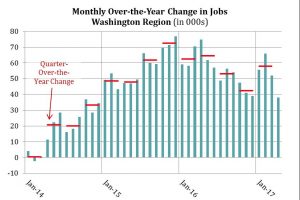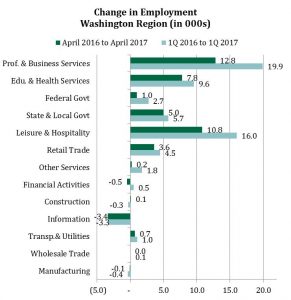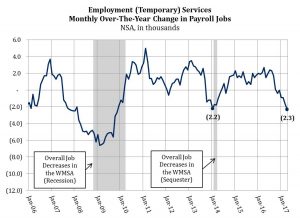Between April 2016 and April 2017, the Washington region added 38,000 jobs, the smallest increase for the region since December 2014. The slowdown in growth was a result of weaker private sector gains and mirrors the pattern from the second half of 2016. Gains during the first half of 2016 were relatively strong but job growth diminished over the course of the second half of the year. During the first quarter of 2017, the region added an average of 57,800 jobs from the same period in 2016 which seemed to mark the reversal of the trend from the second half of 2016. But this strong growth did not continue in April and may indicate a return to a slower growth pattern.

Trends by Sector
In April, growth was led by two sectors: Professional & Business Services (+10,200) and Leisure & Hospitality (+10,800). However, these sectors gained fewer jobs than in prior months. The Professional & Business Services sector added 7,100 fewer jobs in April when compared to the gains in the first quarter. Similarly, the Leisure & Hospitality sector added 5,200 fewer jobs in April when compared to the first quarter, largely due to slower growth in the Food Services and Drinking Places sub-sector. Some of the recent weakness in this sector may be due to seasonal trends.

The Education & Health Services sector added just 7,800 jobs in April 2017. While the April gain was only 1,800 jobs fewer than that in the first quarter, this sector had the sharpest decline during this cycle. In fourth quarter 2015, this sector added an average of 20,300 jobs, the strongest gain on record with data going back to 1991. Gains moderated during 2016 and in the fourth quarter this sector increase by 6,000 jobs. Following the slight uptick in growth during the first quarter 2017 growth nearly returned to its fourth quarter level in April. During the post-sequester period (2014-2016), this sector accounted for nearly one quarter (23.7 percent) of the job growth despite being only 13 percent of the jobs base. The recent pattern suggests that this sector will return to more proportional growth going forward.
Trends in the Employment (Temporary) Services Sub-Sector
Another trend to emerge in 2017 also indicates continued weakness in upcoming months. The Employment Service sub-sector of the Professional & Business Service sector primarily includes temporary/staffing services. This sub-sector has had increasingly negative monthly over-the-year declines throughout 2017. Between April 2016 and April 2017, the number of jobs in the Employment Services sub-sector decreased 2,300, marking the largest decline since our region was still coming out of the Recession in November 2009.

Prolonged job losses in this sub-sector often proceed periods of overall job losses; firms typically shed temporary workers before permanent staff. During the Recession, this sub-sector had declines starting 12 months before the region had overall job losses. During the Sequester, it decreased for the four months prior to overall declines and largely coincided with the overall slowdown in growth. Combined with the lessening of growth in previously strong sectors, recent trends suggest that job growth in 2017 will continue the downward trend of 2016.
About These Data
All data in this post are from the May 19, 2017 release of the Current Employment Statistics from the U.S. Bureau of Labor Statistics, not seasonally adjusted. Quarterly data are the average employment-levels of the three months in that quarter. Quarter-over-the-year changes are the change between the average employment in the quarters.
